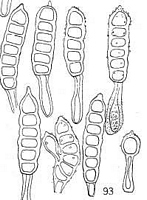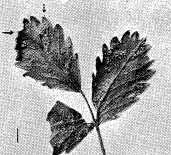|
 Phragmidium acaenae Phragmidium acaenae
SynonymsPhragmidium potentillae
BiostatusPresent in region - Indigenous. Endemic
Images (click to enlarge)
Caption: FIG. 93. Phragmidium Acaenae G.H. Cunn. Teleutospores from Acaena microphylla
Hook. f. | 
Caption: PLATE 1. FIG. 1. Phragmidium Acaenae G.H. Cunn. Caeomata and teleutosori from Acaena
nucrophylla Hook. f. Arrows point to the minute teleutosori. |
Article: Cunningham, G.H. (1924). The Uredinales, or rust-fungi, of New Zealand: supplement to Part 1; and Part 2. Transactions and Proceedings of the New Zealand Institute 55: 1-58 Wellington:.
Description: 0. Spermogones amphigenous, sparse, scattered, conical, pallid yellow.
I. Caeomata hypophyllous, scattered, orbicular when 0-5-1 mm. diam., or elliptical and up to
3 mm. long, pulvinate, pulverulent, orange; encircled by a dense layer of hyaline, incurved,
clavate, persistent paraphyses, overtopping the spores. Spores globose, obovate, or less
commonly elliptical, 18-28 X 16-20 mmm.; epispore hyaline, closely and finely verruculose,
1-1-5 mmm. thick, cell-contents orange, vacuolate.
III. Teleutosori hypophyllous and petiolicolous, sparse, scattered, orbicular, 0.1-0.5 mm.
diam., at first compact and pulvinate, becoming pulverulent, shining-black, naked, with few
spores in each sorus. Spores 4-7-celled, commonly 6, long -cylindrical, 50-95 X 20-25
mmm.; apex bluntly acuminate or rounded, slightly or not thickened, often crowned with a
prominent hyaline papilla, up to 10 mmm. long, not continuous with the upper cell-wall, base
rounded, spore slightly or not narrowed above and below; not or slightly constricted at the
septa; wall light chestnut-brown, 3-4 mm. thick, sparsely covered with a few coarse hyaline
warts which are more numerous apically or may be almost absent; pedicel persistent,
continuous with the spore, tinted above, hyaline below, hollow, up to 50 mmm. long,
commonly much less, 5-9 mmm. thick, swollen at the base to 20 mmm., lower third closely
verruculose, germ-pores 2-3 in each cell, conspicuous.
Notes: The host is endemic, and is not uncommon throughout the mountain districts. (Cheeseman,
1906, p. 132.)
This species closely resembles Phr. subsimile, but differs in the long-cylindrical shape of the
teleutospores, their verrucose apex, much shorter pedicels, and in the cells not being discoid.
Article: Dingley, J.M. (1969). Records of plant diseases in New Zealand. New Zealand Department of Scientific and Industrial Research, Bulletin 192: 298 p. Wellington:.
Notes: The rust is indigenous to New Zealand and is common about Wellington and in the South Island.
Two species of Acaena are indigenous, whilst A. ovina is an Australian species naturalised in
New Zealand.
|